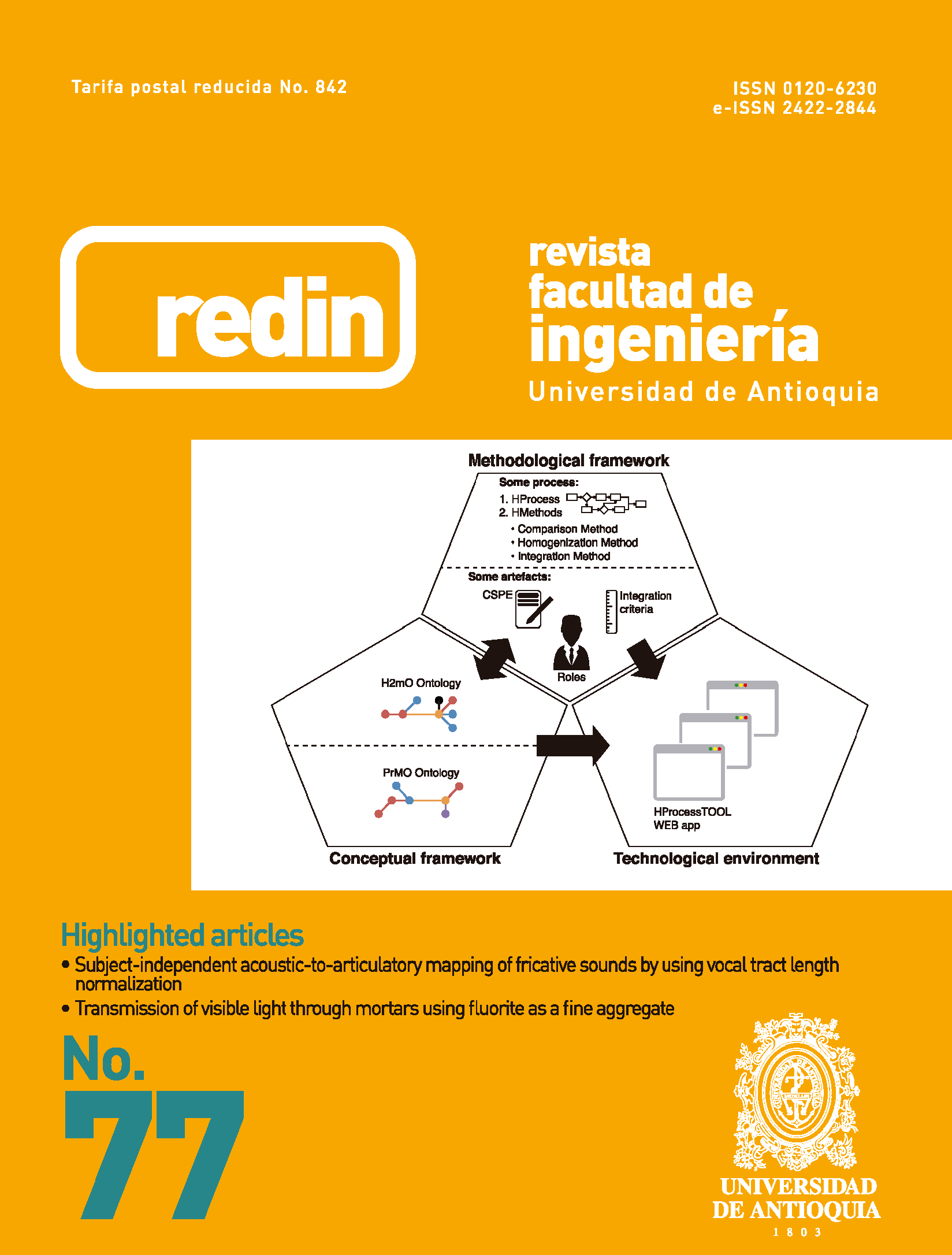Estudio de agregación de asfaltenos provenientes del petróleo crudo colombiano de campo Castilla utilizando simulación molecular
DOI:
https://doi.org/10.17533/udea.redin.n77a04Palabras clave:
simulación molecular, energías de agregación, parámetro de solubilidad, asfaltenResumen
Se presenta un modelo de simulación molecular para estudiar el mecanismo de agregación de asfaltenos. Se seleccionaron cuatro especies, obtenidas a partir de análisis estructurales del petróleo extraído del campo Castilla, en Colombia. Se estudiaron las contribuciones energéticas al proceso de agregación y se calculó el parámetro de solubilidad para cada especie. Finalmente, se estudió el proceso de agregación entre las diferentes especies con el fin de determinar la tendencia de las moléculas hacia la autoasociación. Los resultados muestran que para todas las especies, el estado de agregación es energéticamente favorable, y que tanto las fuerzas de Van der Waals como las fuerzas electrostáticas contribuyen en igual magnitud al proceso de agregación. Se encontró también que la estructura molecular de las moléculas tiene una gran influencia en la manera cómo se agregan los asfaltenos. Para las estructuras continentales, las ramificaciones largas ocasionan un impedimento físico para la agregación. Por otro lado, la flexibilidad asociada a las moléculas tipo archipiélago favorece la agregación con otras especies, pero de alguna manera entorpece la autoasociación. El parámetro de solubilidad para todas las especies se encontró dentro del rango establecido por la literatura.
Descargas
Citas
S. Punnapala and F. Vargas, “Revisiting the PC-SAFT characterization procedure for an improved asphaltene precipitation prediction”, Fuel, vol. 108, pp. 417-429, 2013.
J. Pacheco, I. Zaragoza and J. Martínez, “Asphaltene Aggregation under Vacuum at Different Temperatures by Molecular Dynamics”, Energy & Fuels, vol. 17, pp. 1346-1355, 2003.
E. Buenrostro, C. Lira, A. Gil and J. Wu, “Asphaltene precipitation in crude oils: Theory and experiments”, AIChE J., vol. 50, pp. 2552-2570, 2004.
E. Rogel, “Simulation of Interactions in Asphaltene Aggregates”, Energy & Fuels, vol. 14, pp. 566-574, 2000.
L. Buch et al., “Molecular size of asphaltene fractions obtained from residuum hydrotreatment”, Fuel, vol. 82, pp. 1075-1084, 2003.
O. Mullins, E. Sheu, A. Hammami and A. Marshall, Asphaltenes, Heavy Oils, and Petroleomics, 1st ed. New York, USA: Springer, 2007.
O. Mullins et al., “Advances in Asphaltene Science and the Yen − Mullins Model”, Energy & Fuels, vol. 26, pp. 3986-4003, 2012.
L. Vicente, C. Soto, H. Pacheco, J. Hernández and J. Martinez, “Application of molecular simulation to calculate miscibility of a model asphaltene molecule”, Fluid Phase Equilib., vol. 239, pp. 100-106, 2006.
T. Takanohashi, S. Sato, I. Saito and R. Tanaka, “Molecular Dynamics Simulation of the Heat-Induced Relaxation of Asphaltene Aggregates”, Energy & Fuels, vol. 17, pp. 135-139, 2003.
T. Takanohashi, S. Sato and R. Tanaka, “Structural Relaxation Behaviors of Three Different Asphaltenes Using MD Calculations”, Pet. Sci. Technol., vol. 22, pp. 901-914, 2004.
S. Stoyanov, S. Gusarov and A. Kovalenko, “Multiscale modelling of asphaltene disaggregation”, Mol. Simul., vol. 34, pp. 953-960, 2008.
I. Mackie and G. DiLabio, “Importance of the Inclusion of Dispersion in the Modeling of Asphaltene Dimers”, Energy & Fuels, vol. 24, pp. 6468-6475, 2010.
M. Gray, R. Tykwinski, J. Stryker and X. Tan, “Supramolecular Assembly Model for Aggregation of Petroleum Asphaltenes”, Energy & Fuels, vol. 25, pp. 3125-3134, 2011.
L. Navarro, M. Álvarez, J. Grosso and U. Navarro, “Separación y caracterización de resinas y asfaltenos provenientes del crudo castilla. Evaluación de su interacción molecular”, CT&F Ciencia, Tecnol. y Futur., vol. 2. pp. 53-67, 2004.
S. Plimpton, “Fast Parallel Algorithms for Short – Range Molecular Dynamics”, J. Comput. Physics, vol. 117, pp. 1-19, 1995.
A. Rap and W. Goddard, “Charge Equilibration for Molecular Dynamics Simulations”, J. Phys. Chem., vol. 95, pp. 3358-3363, 1991.
M. Levitt, M. Hirshberg, R. Sharon and V. Daggett, “Potential energy function and parameters for simulations of the molecular dynamics of proteins and nucleic acids in solution”, Comput. Phys. Commun., vol. 91, pp. 215-231, 1995.
F. Frigerio and D. Molinari, “A multiscale approach to the simulation of asphaltenes”, Comput. Theor. Chem., vol. 975, pp. 76-82, 2011.
A. Tharanivasan, “Asphaltene Precipitation from Crude Oil Blends, Conventional Oils, and Oils with Emulsified Water”, Ph.D. dissertation, University of Calgary, Calgary, Canada, 2012.
Descargas
Publicado
Cómo citar
Número
Sección
Licencia
Derechos de autor 2015 Revista Facultad de Ingeniería Universidad de Antioquia

Esta obra está bajo una licencia internacional Creative Commons Atribución-NoComercial-CompartirIgual 4.0.
Los artículos disponibles en la Revista Facultad de Ingeniería, Universidad de Antioquia están bajo la licencia Creative Commons Attribution BY-NC-SA 4.0.
Eres libre de:
Compartir — copiar y redistribuir el material en cualquier medio o formato
Adaptar : remezclar, transformar y construir sobre el material.
Bajo los siguientes términos:
Reconocimiento : debe otorgar el crédito correspondiente , proporcionar un enlace a la licencia e indicar si se realizaron cambios . Puede hacerlo de cualquier manera razonable, pero no de ninguna manera que sugiera que el licenciante lo respalda a usted o su uso.
No comercial : no puede utilizar el material con fines comerciales .
Compartir igual : si remezcla, transforma o construye a partir del material, debe distribuir sus contribuciones bajo la misma licencia que el original.
El material publicado por la revista puede ser distribuido, copiado y exhibido por terceros si se dan los respectivos créditos a la revista, sin ningún costo. No se puede obtener ningún beneficio comercial y las obras derivadas tienen que estar bajo los mismos términos de licencia que el trabajo original.










 Twitter
Twitter